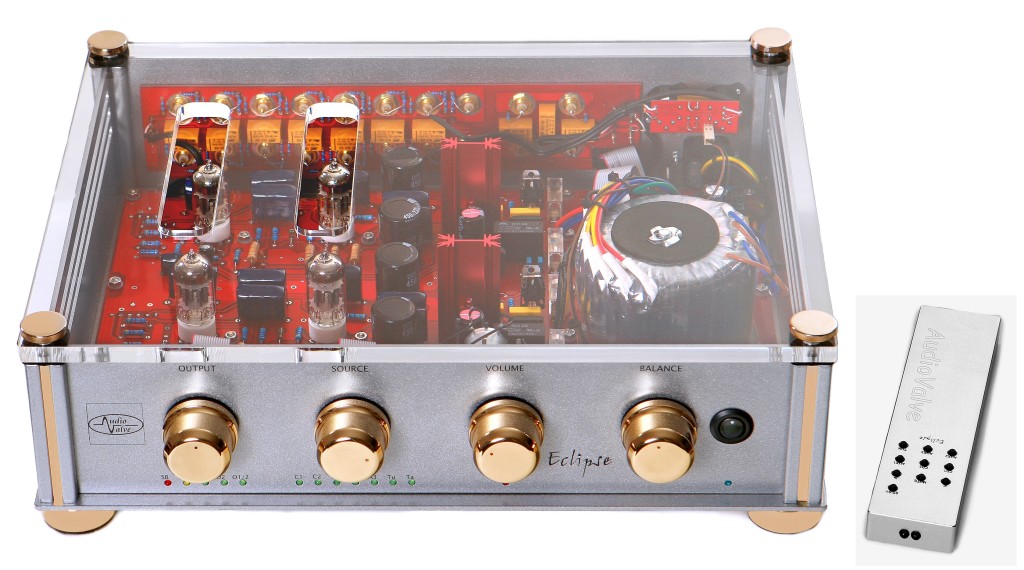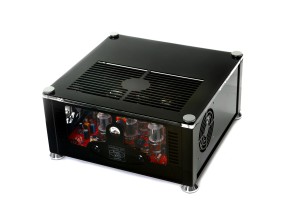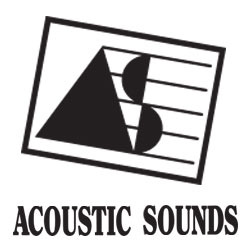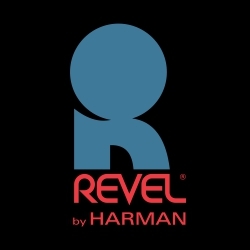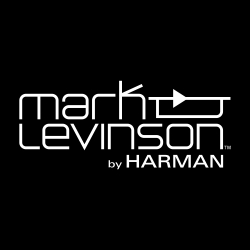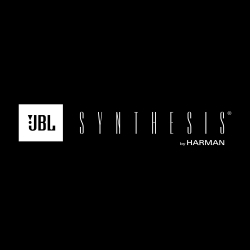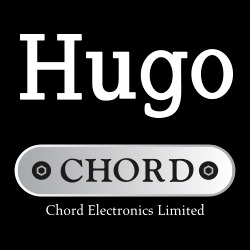Clichés abound when it comes to German manufacturing, and they’re clichés because they’re true. From Braun shavers to Leica cameras, there’s a consistency, durability and desirability which maybe only the Swiss can match. (Hell, they don’t call the Swiss “mountain Krauts” for nothing.) The AudioValve components, though, reflect a different sort of Teutonics, and it’s neither cars nor cameras which they mirror.
A colleague of mine – a Swiss-trained watchmaker, with a passion for Nagra and Revox open-reel tape decks – pointed out to me that there was a peculiar “Germanness” to the latest field of endeavor at which they excel: the manufacture of high-end wristwatches, previously the sole preserve of the Swiss. Not being a watchmaker myself, I can’t claim that I knew what he was talking about when he simply looked at a photo of a new Lange & Söhne watch and said, without prompting, “How very German it is.” He then went onto describe a heaviness to the case, design frills which were purely decorative rather than unremittingly functional – hardly what I expected him to say when “Germanness” to me means the Bauhaus cleanliness of the Audi TT or the pure functionality of a Leica M6. But he was right, and he showed it to me in other German watches. Now I see it all over the AudioValve Eclipse pre-amplifier and Challenger monoblock power amps.
Thus, you can forget the “regular” German gear you know. These pieces have nothing in common with the Munich Airport look of ClearAudio turntables, all chrome and glass, nor do they serve as tube equivalents of the uber-high tech sleekness of Burmester designs. If anything, AudioValve’s look is a throwback to the Weimar Republic. Prussian helmets, handlebar moustaches – subtle it is not. The Eclipse, though a thoroughly modern pre-amp, looks like it was designed by someone who apprenticed at Maybach.
Open the wooden packing crate, and the first thing you notice is that this just may be the heaviest two-channel pre-amp on the market. Unless my bathroom scales are off, the Eclipse weighs a serious 33lb. And yet it only occupies a space of 16.5×12.25x5in (WDH). As the see-through, 3/8in thick plexiglass top plate shows you, this all-tube design is so tidy that there’s a lot of free space within – so what contributes to the weight?
Externally, the Eclipse is not subtle. Four massive, gilded knobs fill the front panel, one each for output select, source select, volume and balance. Below the first two are arrays of colored LEDs to show you which output and source were selected, the first set also flashing during warm-up. Additionally, the source and output selectors have positive detents and the silkiest, sexiest action of any rotary controls I’ve ever used.
At the extreme right are the on/off switch and a sensor for the remote (not supplied with the review sample, but operating all functions including stand-by and mute). So far, so solid, the case itself consisting of glossy metal panels made from laser-cut 5mm sheet steel, used for both structural integrity and to assist in AudioValve’s drive for a pre-amp immune to RFI and unwanted noise. Confirmation was instant: this is one seriously quiet pre-amp. The side panels slot into a chunky extrusion at each corner, each fitted at the bottom with a large gold foot. Another nifty detail? Each foot has a soft insert, like the non-wiry part of a Velcro strip, to ensure that no shelf is damaged. At the back are more military-grade fittings, including an IEC three-pin AC mains input, a pair of XLR balanced outputs, and 10 pairs of sturdy gold phono sockets for outputs 1, 2, tape, and seven inputs marked tape, tuner, Aux 1, 2, 3, and CD 1 and 2.
Looking through the slotted lid, its openings directly above the four 6189/ECC82 tubes, you see one of the main contributors to the unit’s mass: a huge, shielded 100W toroidal transformer, which looks big enough to feed a power amp, let alone a line level pre-amp. The entire circuit and all components reside on a double-sided mother board which fills the base of the unit; obsessives will probably not get around to using the Eklipse for some hours after unpacking because the vista takes in the sort of designer ingredients which cause swoons and will distract them from their original purpose. Everything is mounted with immaculate precision and care; the bank of sockets as seen from the inside is nothing short of inspiring.
Dual-mono construction marks this product, the right and the left channel each enjoying its own power supplies for heat and plate voltage. The seven high level inputs offer different input sensitivities and different input impedances, but – as the new, English owners manual wasn’t ready – I stuck with the CD inputs. Every input is switched by a relay, and the Eklipse features something I’ve never seen before: move to Position 9 on the source selector and you activate the relay self-cleaning function. I did it by accident at first, not knowing it was there, and the flashing lights and machine-gun noises nearly gave me a heart-attack. Designer Helmut Becker recommends its use once a month, so hygiene fanatics – rejoice! (Practical jokers might also use it on unwary friends, just to scare them.)
Each channel uses a pair of tubes, the first for gain and the second for the output driver for low (300 ohm) output impedance. AudioValve chose the ECC82 because they feel it can’t be overdriven. A nice touch for anachrophiles is the use of NOS (new old stock), 40-year-old resistors, chosen for their sonics and stability.* There’s no feedback in the output driver stage, so the company feels that cables will have “no influence on the preamp in this sector.” Suffice it to say, the system did seem immune to cable vagaries, but I stuck with Siltech for the entire listening period; I believe that US editions use Siltech internally.
Clearly an obvious pairing for the Eclipse is the Challenger, a parallel push-pull design with some decidedly interesting details. As with all of the AudioValve electronics, the unit features the company’s patented automatic biasing system, called the Automatic Bias Regulator (ABR), which leads to some fascinating possibilities. Each Challenger has two power tube banks with three tubes per side, for six tubes in total per monoblock. Furthermore, each bank of tubes has its own completely separate power supply, with both banks are connected “anti-parallel” above the transformer.
According to AudioValve, “This principle turns out to offer a very high internal damping, and the big advantage of this is that you don’t use the dynamic of the curve of the tubes; instead the cathode immediately follows the signal of each power tube. So the sound of the Challenger is independent from the characteristics of the tube’s curve.” This results in a series of different wattages for the Challenger according to tube type. The user can install any octal-base beam power pentode compatible with EL34, 6550, or KT88 and so on. (The driver section contains two ECC82s and one ECC83, which shouldn’t be changed for other tube values.)
Think about it: the units come with a dozen of the latest Sovtek EL34s, but anyone lucky enough to have a dozen NOS Gold Lion KT88s, primo vintage EL34s, RCA 6550s or even Gold Lion KT77s can really go to town. Depending on the tubes you select, the amplifiers will deliver between 110W and 140W. The most I could muster for alternatives was eight KT88s and four KT77s, so I had to stick with the supplied tubes, but I can just imagine what the Challenger would sound like with original M-O Valve glassware.
Remember: with the Challenger there is no need to adjust the bias, because this is handled by the circuit. Next to each tube is a red LED which glows in stand-by mode, shutting down when the standby switch is set to “on”. Should a tube ever veer from its correct operating range, the LED glows, telling the user to replace it. As it only takes a minute to remove the plexiglass lid, tube changing is a breeze.
Each Challenger measures 8.5x17x10in (WDH) and weighs 55lb. Here, too, we see massive construction, with laser-cut, slotted metal sides, a metal cylinder at each corner with slots for the side panels, and the aforementioned plexiglass top held, like the Eclipse’s, by large finger-releasable screws. The front has the on-off and standby rocker switches with blue LEDs to indicate status, while the primary mains switch is situated at the back, along with an RCA phono input, an XLR balanced input, and two pairs of WBT binding posts to allow matching for 4, 6 and 8 ohm speaker loads.
Should you disassemble a Challenger, you’ll note the cleverness which produced such a compact amplifier. Just as Mercedes A-Class was designed to be tall and narrow, using the normally wasted space under the passengers’ seats for assorted chores, so, too, does AudioValve utilize space in layers. The main PCB is positioned roughly half-way up, and it contains all of the tubes, the regulation, the capacitors – pretty much everything bar the power supply. That’s positioned below, the massive transformers shielded from the circuitry above. And there’s ventilation everywhere, so the Challenger, though running hot, seems to cooler than I’d expect of an amplifier bearing a half-dozen 6550s.
With the Krell KPS25sc still around (I’m in no rush for it to be collected), I used that as my primary source. I did, though, run the gamut with speakers, the selection including Spendor LS3/5As, which need hardly any power to reach their limits, Wilson WATT Puppy 6, Quad ESLs (57 and 63) and a quick burst through the Apogee Scintillas of the 1 ohm variety.
Not being a savage, I tried the Apogees just to see if the AudioValve amplifier would drive them; previously, the only tube amps I used with my Apogees which didn’t burst into flames or merely expire were the late, lamented Beard P100 monoblocks. The Challenger certainly provided enough juice to allow the Scintillas to work adequately in my 12x18ft room, at my preferred and admittedly soft levels, but this was just for a laugh. But I thought you should know, in case you’re a sadist. I don’t really recommend it – for 1 ohm loads, I stick with Krell and the like – but it is an interesting litmus test with possibly costly results.
Back with the Wilsons, it just was not what I expected. Previous experience with Teutonic tube amps – I’d just reviewed an Octave pre-amp for a British magazine, and have also used Klimo, Kebschull, and others – led me to conclude that German designers want their tube amps to behave with the etiquette associated with transistors: cool, clean, tight, analytical, with just a hint of tube-ness. Clearly, Herr Becker prefers warmth, a sound more zaftig than the others, more Brunhilde than Claudia Schiffer.
At no point was power ever an issue; according to AudioValve, the 6550 and KT88 endow the Challenger with 140W output, whereas the EL34 or KT77 deliver performance at the lower power limit. (Looking at the various tube tables I have to hand, this also suggests that AudioValve isn’t running the tubes too hard, either, because 23.3W from each 6550/KT88 and 18.3W from each EL34 are well within their capabilities.) Considering that I’d just been using 300W of Krell power on the Wilsons prior to the AudioValve’s arrival, it says much about the German tube amps that there appeared to be no sacrifices whatsoever in terms of dynamic qualities.
Abundant SPLs, exquisitely rapid changes from softest to loudest, crisp transients regardless of frequency: that’s the Germanic side of it, dealt with as a matter of course rather than as an over-riding signature. As expected, the AudioValves dealt with large works – yup, the Glory soundtrack – with ease. No compression, no clipping, no running out of steam. What tempers these seemingly solid-state virtues are the tube touches, and it’s here that we find one of those rare amps (like the big Audio Research and c-j models) which can convert tranny heads.
Without compromising any of the traits which make a tube amp the choice of many, AudioValve has instilled the sort of composure and control normally attributed to 150W-plus solid-state devices. The slam, the top-to-bottom control, the sheer mass – all are present. But so, too, are the deliriously tube-y qualities which keep me forever wedded to my old Quads and Radfords; in fact, the Challenger with EL34s sounds like a Radford STA25 on steroids. There’s a spatial spread which both suggests that your room has suddenly grown deeper and wider, along with a facility for helping speakers to disappear (assuming that, like most ESLs and most well-designed point sources, the speakers allow it). Here, the teensy LS3/5As proved most-blessed, because the AudioValve exploited the BBC design’s life-like mid-band and where’d-the-speaker-go? dispersion characteristics in a manner never dreamed of by the LS3/5A design team.
But 110W into a tiny two-way designed in ’75 isn’t exactly normal usage of a cutting edge tube design, so the serious listening involved the Wilsons. Most telling of all was the bottom end, which, while slightly less solid and tight than when derived from the Krell FPB300c, displayed none of the flubbing or looseness which the anti-tube brigade always uses as a get-out clause. And while you’d make no mistake that you’re hearing something other than a big Krell, the giveaway would not be the extension: the Challenger goes deep. I’d recently been revelling in the new Al Green package from Edsel in the UK, and Willie Mitchell productions always boast the sort of fluid bass which can embarrass a lot of systems. Well, stone me: these Germans have soul.
To try and separate the Eclipse form the Challenger, I swapped them around with the Krell equivalents. If there are any deficiencies in one being compensated for by the other, I couldn’t detect them. Both exhibited the same spatial characteristics, smoothness and detail retrieval. As the Eclipse proved ghostly quiet, with only the slightest hint of tube noise when ear is placed next to speaker, I was able to determine that the Challenger has a shade more of the low-level whoosh than the pre-amp. But I compared it to two other octal-base amplifiers I had handy – both champions in the quietness stake – and determined that it was the tubes rather than the Challenger per se.
For the curious, the other amplifiers used two and four valves per channel, 6550s and KT88s. While I didn’t have enough to re-tube the Challengers, as I said before, it did give me the opportunity to compare AudioValve’s Sovtek EL34s with Gold Lion KT-88s and unbranded 6550s. Power aside, the Russkies were slightly softer at the extremes and exhibited a trace less punch; conversely, they were richer in the midband and more vocals-friendly, as demonstrated by the lush “Rivers Of Babylon” on Ronstadt’s Hasten Down The Wind and the Judds’ take of “Don’t Be Cruel”. Now I know that a dozen tubes of any sort is a serious investment, so I’m not suggesting profligate tube experimentation. But it sure is nice to know that you can convert the Challenger for either reasons of either economy or sound.
It was easy to fall in love with the AudioValve pair, even the baroque styling; it was like looking at a gigantic Montblanc pen. The Eclipse impressed me because of its authoritative performance, openness, ergonomics and build quality. The Challengers? Deceptive they are, like U-boats. Small footprint, not too heavy for a 6-valve amp with huge transformers – yet they drive any load without complaint, maintaining their composure at all times. Yeah, I could live with these without complaint.
Unusually, given its country of origin, the AudioValve set-up suffers not the traditional German curse of being over-priced; forgive me, but it seems like a bargain. As one who utterly despises the manoeuvrings of European Community – the largest scam ever perpetrated on an entire continent – I am pleased to note that all currencies linked to the Euro, including the once mighty Deutschmark, have been devalued against the dollar. With the Euro tanking – just writing that gives me a woody! – a pair of Challengers sells for $7,900, while the Eclipse (with remote) costs only $3,490. These are the sort of prices you’d expect to pay for top-notch home-grown gear, let alone European imports, and if you told me to double them, I’d still think they were worth considering. Grab yours now, before the non-elected, corrupt scum in Brussels artificially shore up the benighted currency.
_______________
*I wonder how many Eclipses AudioValve can produce before they run out of these rare resistors…
(Ultimate Audio, 2000)

